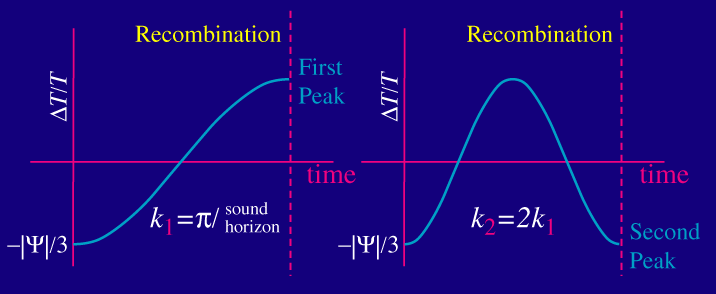Harmonic Extrema
Key Concepts:
-
Oscillations are frozen
in at recombination
-
Modes caught at extrema
of their oscillation represent peaks
? characteristic scales with enhanced temperature fluctuations
-
The wavenumbers (or spatial frequency) of the peaks
are harmonically
related to the fundamental scale ? the distance sound can travel by recombination
Now we can understand where the peaks come from.
Sound waves stop oscillating
at recombination
when the baryons release the photons. Modes that reach extrema
of their oscillation (maximal compression or rarefaction in potential wells)
by recombination will carry enhanced temperature
fluctuations.
Let's plot the temperature fluctuation at say the
bottom of a potential well of a mode of a given wavenumber (inverse wavelength)
k1. It will oscillate
in time as the fluid compresses and rarefies.
There is a special mode for which the fluid just has enough time to compress
once before recombination:

Mathematically the wavenumber (2pi/wavelength) of
this mode (k1)
is equal to pi divided by the distance sound can travel by recombination.
This distance is called the sound horizon
at recombination.
Because the mode with twice the wavenumber (half
the wavelength) oscillates twice as fast, we know that there is a mode
k2=2k1
which just has time to compress and then rarefy before recombination.
Likewise there is a mode k3=3k1
which just has time to compress and then rarefy and then compress again.
These modes represent the first, second and third peaks respectively.
They are harmonics of the fundamental scale
? the distance sound can travel before recombination.
A helpful way to remember the principle behind this
harmonic relation is to recall what happens to sound
in a cavity of a musical instrument.
There are frequency harmonics
of the fundamental tone.
In this case, the cavity is actually the amount of time before recombination
and thus there exists a fundamental frequency as well. Because sound
travels at a fixed speed we can also associate a fundamental
scale to this frequency. That scale
is exactly the distance sound can travel in the amount of time before recombination.
Don't take this analogy too far:
the waves are still incoherent in space so the waves would "sound" like
noise not music.

